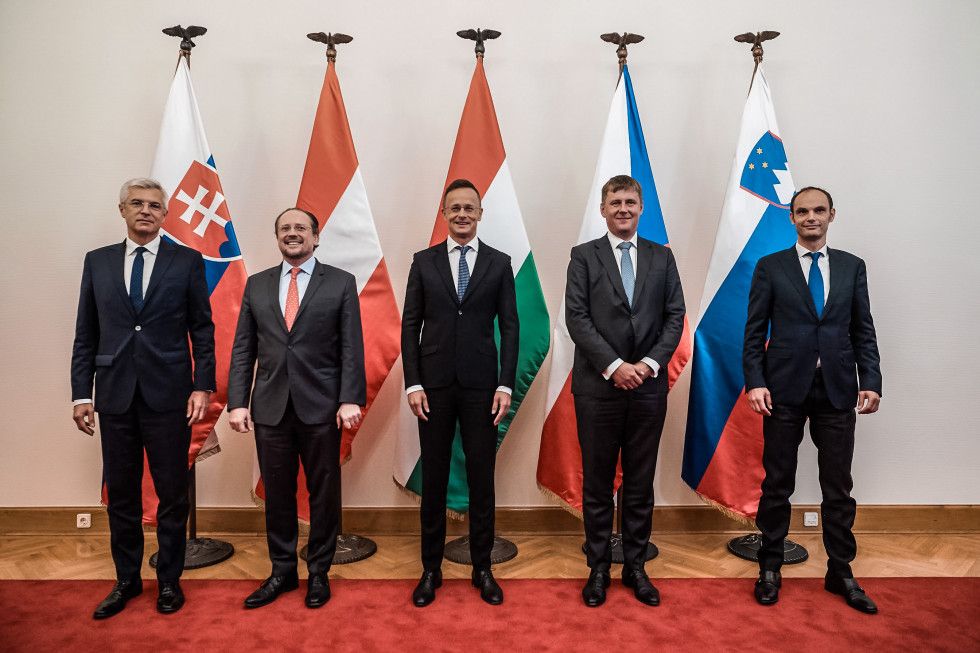The Central Five: Wrapping Up the Forum’s First Year

The Central Five is a non-institutionalised formula of regional cooperation in Central Europe. So far, seven C5 meetings have been held, including one virtual session and one on the margins of the EU summit, all at the level of foreign ministers. Despite coordination in various fields, the C5’s loose nature is indicated by the fact that none of its summits was crowned with a joint written declaration.
Motivations for Calling and Continuing the C5
The forum was formed primarily to facilitate the coordination of border-control management after the outbreak of the pandemic. The C5 was established at Austria’s initiative in June 2020. This was when European countries loosened restrictions after the spring wave of infections—including those concerning the freedom to cross borders—but restrictions on air connections kept travel difficult. This is why it became important to facilitate land movement within the immediate neighbourhood and to restore tourist traffic as the pandemic situation started improving. This was essential because in 2019 around 11% of Austria’s and Slovenia’s GDP came from tourism. However, the C5 countries did not agree common entry regulations, therefore they applied EU and bilateral solutions.
Despite this failure, the continuation of the C5’s activities came to be driven by the motivations of individual countries and their willingness to use the new platform to convince regional partners to their policies. For Austria, which is the only C5 country that shares borders with all its members, the Central Five is another platform enabling better coordination of its own activities in the region. In turn, Slovenia signalled the possibility of engaging the new platform in accelerating the integration of the Western Balkan countries with the EU. Czechia and Slovakia, which adopted some of the most restrictive laws in the EU to fight the pandemic in spring 2020, wanted to use the C5 to manage the restrictions more effectively. Hungary, which has been closed to foreigners since September 2020, used the Central Five to, among others, criticise European Commission actions and to defend vaccinations with the Russian preparation Sputnik V.
Directions of Cooperation
Taking up topics other than those related to the original goal of coordinating border control, the Central Five initially began to evolve into a consultation platform on issues related to the EU approach to the pandemic. For example, ministers called for the faster approval of vaccines by the European Medicines Agency (EMA). The C5 was therefore used to amplify the voice of Hungary, which vaccinated residents with Russian and Chinese preparations not approved by the EMA. Austria, on the other hand, won the support of the other C5 countries for its initiative of “green” passports—certificates that allow people, including those who have been vaccinated against COVID-19, to travel around the EU. Over time, however, the topics of the meetings went beyond pandemic issues. The ministers of the five countries, which are linked by a relatively restrictive migration policy, discussed the new pact on migration and asylum, and other measures.
In its first year, the Central Five began to show ambition to engage in issues related to third countries. During the Bratislava summit in May this year—in the “C5+” format with the Minister of Foreign Affairs of Ukraine Dmytro Kuleba—Slovakia secured joint C5 support for Ukrainian territorial integrity and sovereignty, even though the relations of the platform members with Russia are different. In turn, the C5 meetings in Slovenia were used not only to discuss the situation in Belarus but also by Foreign Minister Anže Logar to announce that EU summits with the Eastern Partnership and Western Balkan countries will be held during the Slovenian presidency of the EU Council in the second half of the year. Moreover, Logar promoted the May visit by the foreign ministers of Austria, Czechia, and Slovenia to Albania and North Macedonia under the C5 brand—something that Macedonian Foreign Minister Bujar Osmani also referred to. In addition to topics related to the EU’s nearest surrounding, the C5 ministers also discuss more distant current events, such as the escalation of the Israeli-Palestinian conflict.
Conclusions and Perspectives
The formation of the C5 was in line with the trend of looking for new formats of cooperation in Central and Eastern Europe. In recent years, the Lublin Triangle (2020), the Varna Quadrilateral (2017), the Three Seas Initiative (2016), the Bucharest Nine, and the Slavkov Triangle (2015) were established. They complement the Visegrad Group (1991), which is the most important regional platform for all its members, with incomparably extensive instruments of consultation and coordination, and the dysfunctional Central European Initiative (1989).
The original assumptions of the C5 cooperation regarding the regulation of border crossings during the pandemic have not been achieved. Nevertheless, and despite a decline in the intensity of meetings—the first four took place within four months of the initiation of the C5—these countries have maintained consultations on other pandemic-related issues. The durability of the C5 is demonstrated by its functioning despite a change in foreign minister (Czechia) and friction between the Slovak and Hungarian ministers, including in connection with plans to change the law on citizenship in Slovakia. The prospects for continuing the project is demonstrated, however, by it going beyond the original scope of the coordination of border activities.
Although members of the C5 deny that it competes with the Visegrad Group, it may yet do so if the coordination of EU issues—the primary focus of the V4’s actions—including neighbourhood policy is further enhanced. In particular, the activity of the non-Visegrad Austria and Slovenia—the most involved in developing the new initiative—show that they are interested in making the C5 their main platform for regional cooperation in Central Europe. At the same time, they are also the most active of the five countries in the Western Balkans. Due to the interest of all C5 countries in this region, an attempt to intensify activities in the Balkans in the new format would constitute a challenge for Poland. There would be a risk that some activities could take place at the expense of Czechia, Slovakia, and Hungary’s participation in Visegrad activities in the region.
It is also unfavourable for Poland if the voice of Central European states towards the EU’s eastern neighbourhood becomes less intelligible. The present governments of Austria, Slovenia, and Hungary either sympathise with the Russian authorities or openly support some of its actions. The numerical dominance of these countries in the new format means that it will be even more difficult than in the Visegrad Group to hear a C5 voice contrary to Russian interests. This was demonstrated at the summit of the five countries in September 2020 during the period of protests in Belarus after the rigged presidential elections when—despite the topic being discussed—no joint conclusions were agreed. Although the clear difference of opinion makes it unlikely that the C5 will take a position directly in favour of Russia, the passivity of the new group of Central European countries on eastern matters is unfavourable from the perspective of both Poland and the EU in their ambitions to expand the area of security, stability, and democracy.
The C5 states’ level of involvement may be changing. Clearer support from Czechia for the C5’s work at the expense of the V4 may come after the October parliamentary elections if the Czech Pirate Party and the Mayors and Independents (STAN) group—a coalition sceptical of the V4—succeed. In turn, if the opposition wins next year’s elections in Hungary, they may distance themselves from the Slovenian initiatives of the government of national-conservative Prime Minister Janez Janša, a political ally of Prime Minister Viktor Orbán.
While Poland initiates, co-creates, and supports new formats of regional cooperation in Central Europe, it is in its interest to ensure that they do not duplicate proven mechanisms of policy coordination, including EU policy. Therefore, regardless of the direction of the C5’s development, Poland may mobilise its Visegrad partners to increased involvement in the coordination of EU policy within the V4, including in particular regarding the EU’s immediate environment. An occasion to do so will be the commencement on 1 July of the presidency of the Visegrad Group by Hungary, which remains Poland’s closest partner in European politics.



